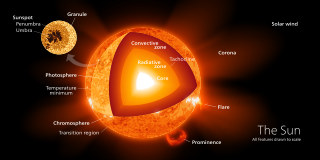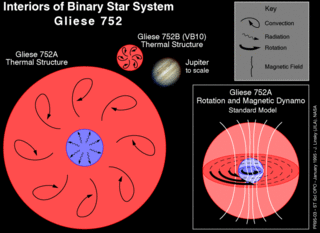Related Research Articles

In astronomy, the main sequence is a continuous and distinctive band of stars that appears on plots of stellar color versus brightness. These color-magnitude plots are known as Hertzsprung–Russell diagrams after their co-developers, Ejnar Hertzsprung and Henry Norris Russell. Stars on this band are known as main-sequence stars or dwarf stars. These are the most numerous true stars in the universe, and include the Sun.

A star is an astronomical object comprising a luminous spheroid of plasma held together by its gravity. The nearest star to Earth is the Sun. Many other stars are visible to the naked eye at night, but their immense distances from Earth make them appear as fixed points of light. The most prominent stars have been categorised into constellations and asterisms, and many of the brightest stars have proper names. Astronomers have assembled star catalogues that identify the known stars and provide standardized stellar designations. The observable universe contains an estimated 1022 to 1024 stars. Only about 4,000 of these stars are visible to the naked eye, all within the Milky Way galaxy.

Star formation is the process by which dense regions within molecular clouds in interstellar space, sometimes referred to as "stellar nurseries" or "star-forming regions", collapse and form stars. As a branch of astronomy, star formation includes the study of the interstellar medium (ISM) and giant molecular clouds (GMC) as precursors to the star formation process, and the study of protostars and young stellar objects as its immediate products. It is closely related to planet formation, another branch of astronomy. Star formation theory, as well as accounting for the formation of a single star, must also account for the statistics of binary stars and the initial mass function. Most stars do not form in isolation but as part of a group of stars referred as star clusters or stellar associations.
Differential rotation is seen when different parts of a rotating object move with different angular velocities at different latitudes and/or depths of the body and/or in time. This indicates that the object is not solid. In fluid objects, such as accretion disks, this leads to shearing. Galaxies and protostars usually show differential rotation; examples in the Solar System include the Sun, Jupiter and Saturn.

Red supergiants (RSGs) are stars with a supergiant luminosity class of spectral type K or M. They are the largest stars in the universe in terms of volume, although they are not the most massive or luminous. Betelgeuse and Antares are the brightest and best known red supergiants (RSGs), indeed the only first magnitude red supergiant stars.

CoRoT was a space telescope mission which operated from 2006 to 2013. The mission's two objectives were to search for extrasolar planets with short orbital periods, particularly those of large terrestrial size, and to perform asteroseismology by measuring solar-like oscillations in stars. The mission was led by the French Space Agency (CNES) in conjunction with the European Space Agency (ESA) and other international partners.

Stellar structure models describe the internal structure of a star in detail and make predictions about the luminosity, the color and the future evolution of the star. Different classes and ages of stars have different internal structures, reflecting their elemental makeup and energy transport mechanisms.

A radiation zone, or radiative region is a layer of a star's interior where energy is primarily transported toward the exterior by means of radiative diffusion and thermal conduction, rather than by convection. Energy travels through the radiation zone in the form of electromagnetic radiation as photons.

A convection zone, convective zone or convective region of a star is a layer which is unstable due to convection. Energy is primarily or partially transported by convection in such a region. In a radiation zone, energy is transported by radiation and conduction.

A subgiant is a star that is brighter than a normal main-sequence star of the same spectral class, but not as bright as giant stars. The term subgiant is applied both to a particular spectral luminosity class and to a stage in the evolution of a star.
18 Andromedae, abbreviated 18 And, is a single star in the northern constellation of Andromeda. 18 Andromedae is the Flamsteed designation. It is visible to the naked eye with an apparent visual magnitude of 5.350. The annual parallax shift of 7.9 mas can be used to estimate a distance of 413 light years. It is moving further from the Earth with a heliocentric radial velocity of +10 km/s.

A yellow hypergiant (YHG) is a massive star with an extended atmosphere, a spectral class from A to K, and, starting with an initial mass of about 20–60 solar masses, has lost as much as half that mass. They are amongst the most visually luminous stars, with absolute magnitude (MV) around −9, but also one of the rarest, with just 20 known in the Milky Way and six of those in just a single cluster. They are sometimes referred to as cool hypergiants in comparison with O- and B-type stars, and sometimes as warm hypergiants in comparison with red supergiants.

The tachocline is the transition region of stars of more than 0.3 solar masses, between the radiative interior and the differentially rotating outer convective zone. This causes the region to have a very large shear as the rotation rate changes very rapidly. The convective exterior rotates as a normal fluid with differential rotation with the poles rotating slowly and the equator rotating quickly. The radiative interior exhibits solid-body rotation, possibly due to a fossil field. The rotation rate through the interior is roughly equal to the rotation rate at mid-latitudes, i.e. in-between the rate at the slow poles and the fast equator. Recent results from helioseismology indicate that the tachocline is located at a radius of at most 0.70 times the solar radius, with a thickness of 0.04 times the solar radius. This would mean the area has a very large shear profile that is one way that large scale magnetic fields can be formed.
The standard solar model (SSM) is a mathematical treatment of the Sun as a spherical ball of gas. This model, technically the spherically symmetric quasi-static model of a star, has stellar structure described by several differential equations derived from basic physical principles. The model is constrained by boundary conditions, namely the luminosity, radius, age and composition of the Sun, which are well determined. The age of the Sun cannot be measured directly; one way to estimate it is from the age of the oldest meteorites, and models of the evolution of the Solar System. The composition in the photosphere of the modern-day Sun, by mass, is 74.9% hydrogen and 23.8% helium. All heavier elements, called metals in astronomy, account for less than 2 percent of the mass. The SSM is used to test the validity of stellar evolution theory. In fact, the only way to determine the two free parameters of the stellar evolution model, the helium abundance and the mixing length parameter, are to adjust the SSM to "fit" the observed Sun.

A red giant is a luminous giant star of low or intermediate mass in a late phase of stellar evolution. The outer atmosphere is inflated and tenuous, making the radius large and the surface temperature around 5,000 K or lower. The appearance of the red giant is from yellow-white to reddish-orange, including the spectral types K and M, sometimes G, but also class S stars and most carbon stars.
GJ 3379 is the nearest star in the Orion constellation, located at a distance of 17 light years from the Sun based on parallax. It is a single star with an apparent visual magnitude of +11.31 and an absolute magnitude of +12.71, therefore, the star is not visible with the naked eye. It is positioned in the upper left part of the Orion constellation, to the SSE of Betelgeuse. This star is drifting further away with a radial velocity of +30.0 kilometers per second. In the past, this star had a relatively close encounter with the Solar System. Some 161,000±6,000 years ago, it achieved a minimum distance of 4.08 ± 0.20 ly (1.25 ± 0.06 pc).

Gliese 752 is a binary star system in the Aquila constellation. This system is relatively nearby, at a distance of about 19 light years.
Deuterium fusion, also called deuterium burning, is a nuclear fusion reaction that occurs in stars and some substellar objects, in which a deuterium nucleus and a proton combine to form a helium-3 nucleus. It occurs as the second stage of the proton–proton chain reaction, in which a deuterium nucleus formed from two protons fuses with another proton, but can also proceed from primordial deuterium.

An O-type star is a hot, blue-white star of spectral type O in the Yerkes classification system employed by astronomers. They have temperatures in excess of 30,000 kelvin (K). Stars of this type have strong absorption lines of ionised helium, strong lines of other ionised elements, and hydrogen and neutral helium lines weaker than spectral type B.
Gliese 754 is a dim star in the southern constellation of Telescopium. It has an apparent visual magnitude of 12.25, which requires a telescope to view. The star is located at a distance of 19.3 light-years from the Sun based on parallax, and it is drifting further away with a radial velocity of +7 km/s. It is one of the hundred closest stars to the Solar System. Calculations of its orbit around the Milky Way showed that it is eccentric, and indicate that it might be a thick disk object.
References
- ↑ Gilman, Peter A. (2000). "Fluid Dynamics and MHD of the Solar Convection Zone and Tachocline: Current Understanding and Unsolved Problems (Invited Review)". Helioseismic Diagnostics of Solar Convection and Activity. pp. 27–48. doi:10.1007/978-94-011-4377-6_2. ISBN 978-94-010-5882-7.
- ↑ Johnston, C. (11 August 2021). "One size does not fit all: Evidence for a range of mixing efficiencies in stellar evolution calculations". Astronomy & Astrophysics. 655: A29. arXiv: 2107.09075 . doi:10.1051/0004-6361/202141080. S2CID 236134214.
- ↑ Montalbán, J.; Miglio, A.; Noels, A.; Dupret, M.-A.; Scuflaire, R.; Ventura, P. (2013). "Testing Convective-core Overshooting Using Period Spacings of Dipole Modes in Red Giants". The Astrophysical Journal. 766 (2): 118. arXiv: 1302.3173 . Bibcode:2013ApJ...766..118M. doi:10.1088/0004-637X/766/2/118. S2CID 56136035.
- ↑ Torres, Guillermo; Vaz, Luiz Paulo R.; Sandberg Lacy, Claud H.; Claret, Antonio (2014). "Absolute Properties of the Eclipsing Binary System AQ Serpentis: A Stringent Test of Convective Core Overshooting in Stellar Evolution Models". The Astronomical Journal. 147 (2): 36. arXiv: 1312.1352 . Bibcode:2014AJ....147...36T. doi:10.1088/0004-6256/147/2/36. S2CID 119252536.